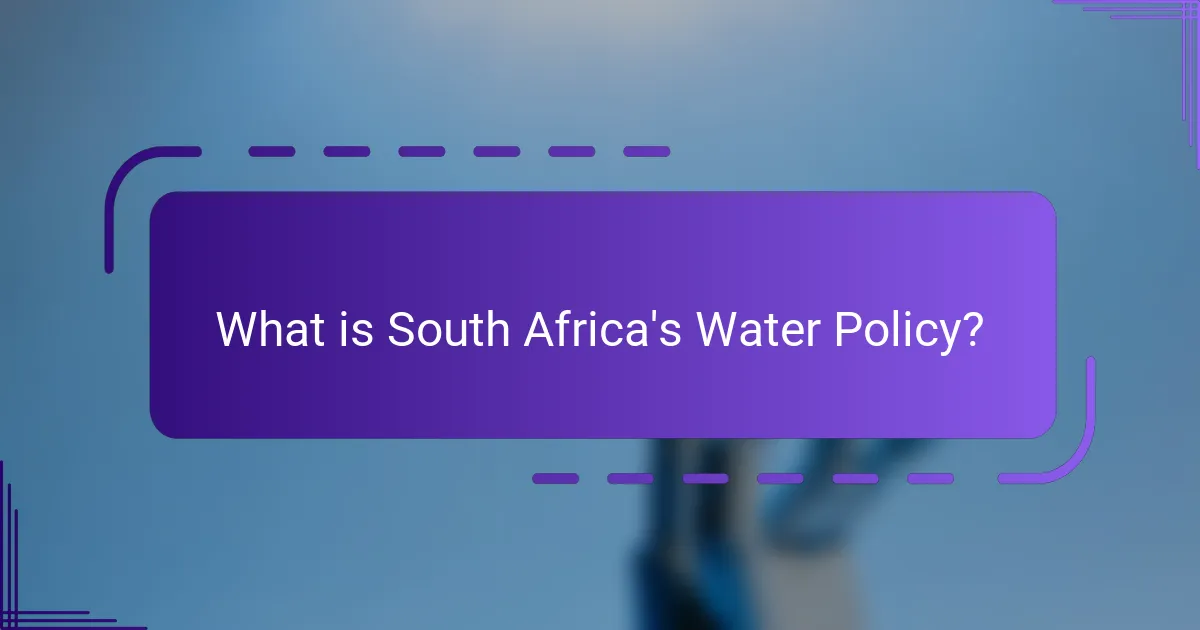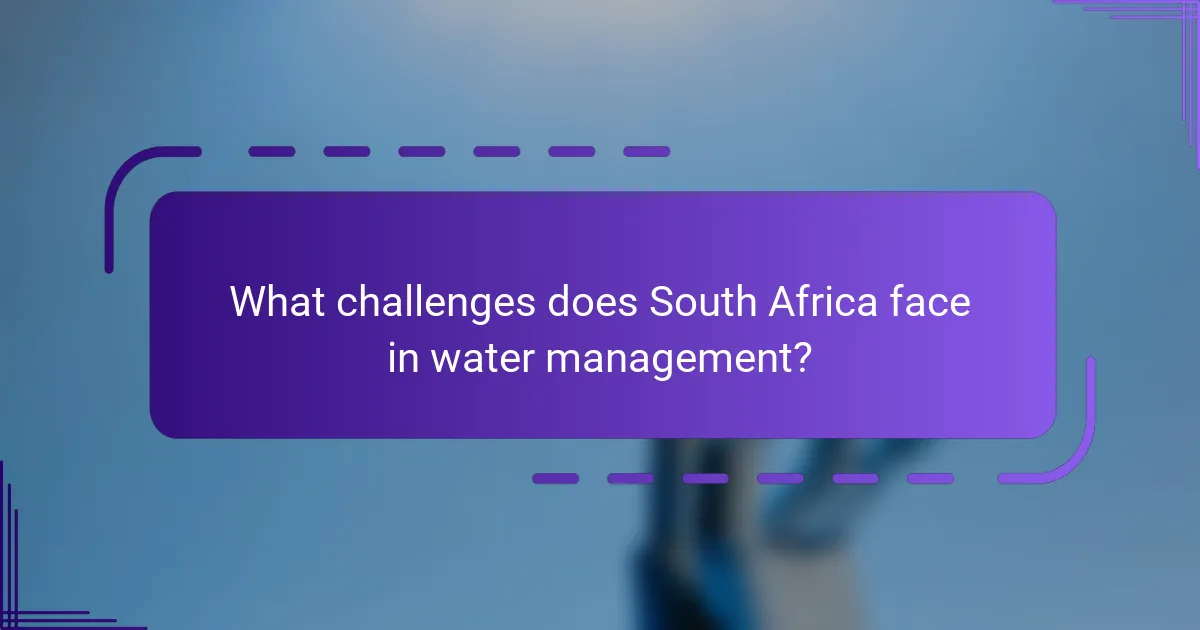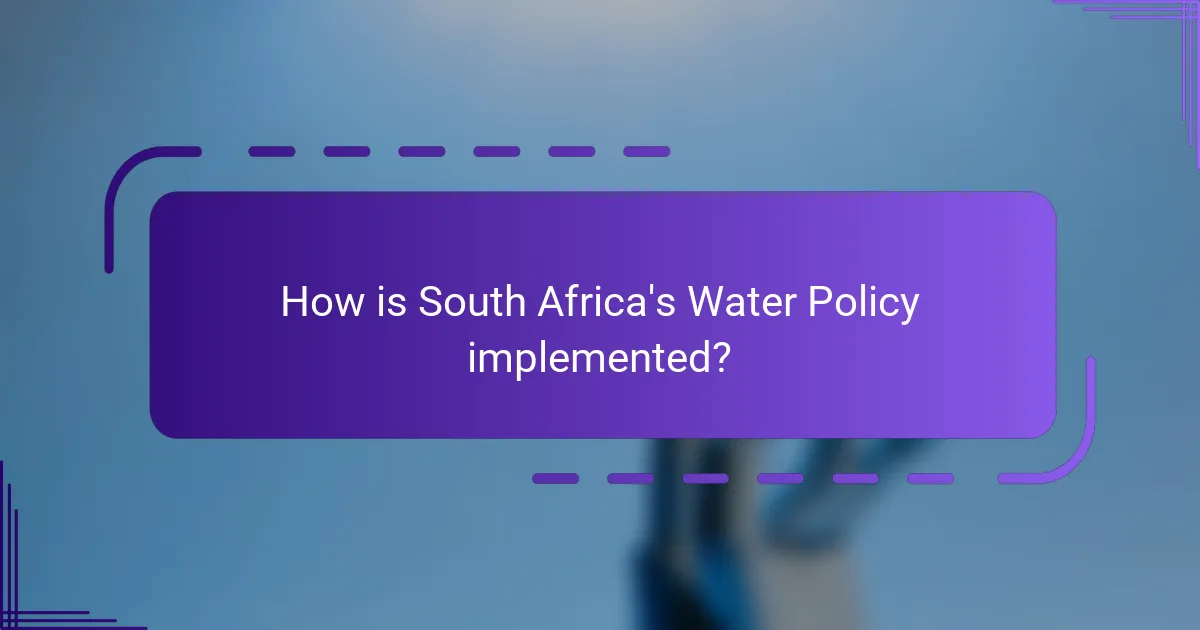South Africa’s Water Policy aims to ensure equitable access to water resources while prioritizing sustainable management of this finite resource. Guided by the National Water Act of 1998, the policy emphasizes integrated water resource management and community participation. It addresses historical inequalities in water distribution and aims to protect water resources from pollution and over-extraction. The article examines the significant challenges South Africa faces in water management, including water scarcity, climate change impacts, and socioeconomic disparities. It also outlines the framework for policy implementation, which involves multiple levels of government and the use of Integrated Water Resource Management strategies to facilitate stakeholder engagement and ensure effective governance.

What is South Africa’s Water Policy?
South Africa’s Water Policy aims to ensure equitable access to water resources. It prioritizes the sustainable management of water as a finite resource. The policy is guided by the National Water Act of 1998. This act emphasizes the need for integrated water resource management. It also promotes the participation of communities in water management. The policy addresses historical inequalities in water distribution. It aims to protect water resources from pollution and over-extraction. The government implements strategies to improve water quality and availability.
How is South Africa’s Water Policy structured?
South Africa’s Water Policy is structured around the National Water Act of 1998. This act promotes equitable access to water resources. It emphasizes sustainability and the protection of water ecosystems. The policy framework includes the Integrated Water Resource Management approach. This approach involves collaboration among government, communities, and stakeholders. The policy also identifies water as a public resource. Water management is decentralized to regional authorities. The policy aims to address historical inequalities in water access. It includes provisions for water quality management and conservation efforts.
What are the key components of the Water Policy framework?
The key components of the Water Policy framework include water resource management, water quality protection, and equitable access to water. Water resource management focuses on sustainable use and allocation of water resources. This involves integrated planning and management to balance social, economic, and environmental needs. Water quality protection aims to maintain and improve water quality standards. This is essential for public health and ecosystem integrity. Equitable access to water ensures that all communities have access to safe and sufficient water. This is crucial for addressing historical inequalities in South Africa. These components are designed to support sustainable development and efficient water use in the country.
What principles guide the formulation of the Water Policy?
The principles guiding the formulation of the Water Policy include sustainability, equity, and integrated management. Sustainability ensures that water resources are used responsibly for future generations. Equity addresses fair access to water for all communities, particularly marginalized groups. Integrated management promotes a holistic approach, coordinating water management across sectors and stakeholders. These principles are essential for addressing South Africa’s unique water challenges, such as scarcity and inequality. They align with the National Water Act of 1998, which emphasizes the need for equitable resource distribution and sustainable practices.
Why is water policy important for South Africa?
Water policy is crucial for South Africa due to its limited water resources and high demand. The country faces severe water scarcity, impacting agriculture, industry, and domestic use. Effective water policy ensures sustainable management of these resources. It addresses issues like water quality, access, and equitable distribution. South Africa’s water policy aims to promote conservation and efficient usage. The National Water Act of 1998 is a key framework guiding these efforts. This act emphasizes the need for integrated water resource management. It also aims to rectify past inequalities in water access. Without a strong water policy, South Africa risks exacerbating its water crisis.
How does water policy impact public health and safety?
Water policy significantly impacts public health and safety by regulating water quality and availability. Effective water policy ensures access to safe drinking water. This reduces the risk of waterborne diseases, which affect millions globally. In South Africa, inadequate water management can lead to outbreaks of cholera and other illnesses. According to the World Health Organization, safe water access is crucial for preventing disease. Furthermore, water policy influences sanitation practices, directly affecting community health. Poor sanitation can lead to environmental contamination and health hazards. Thus, comprehensive water policies are essential for safeguarding public health and ensuring safety in communities.
What role does water policy play in economic development?
Water policy plays a critical role in economic development by ensuring sustainable water management. Effective water policies promote efficient water use in agriculture, industry, and domestic sectors. They facilitate access to clean water, which improves public health and productivity. For example, the World Bank states that every $1 invested in water and sanitation yields a return of $4 in economic benefits. Additionally, sound water policies attract investment by providing reliable water resources for businesses. In South Africa, addressing water scarcity through policy can enhance food security and boost economic growth. Therefore, comprehensive water policies are essential for fostering economic resilience and development.

What challenges does South Africa face in water management?
South Africa faces significant challenges in water management. Water scarcity is a primary issue, with the country classified as water-stressed. The demand for water exceeds supply in many regions. Climate change exacerbates this problem, leading to unpredictable rainfall patterns. Aging infrastructure contributes to water loss through leaks and inefficiencies. Pollution of water sources further diminishes available clean water. Socioeconomic disparities affect access to water, particularly in rural areas. Governance issues hinder effective water resource management and policy implementation. These challenges require comprehensive strategies for sustainable water management in South Africa.
What are the main issues affecting water availability?
The main issues affecting water availability include climate change, population growth, and pollution. Climate change leads to altered rainfall patterns and increased droughts. These changes reduce the overall water supply in many regions. Population growth increases demand for water, putting additional pressure on existing resources. Pollution from industrial, agricultural, and urban sources further degrades water quality. This contamination limits the usability of available water. According to the World Health Organization, around 2 billion people lack access to safe drinking water, highlighting the severity of these issues. In South Africa, these factors contribute to significant water scarcity challenges.
How does climate change impact water resources in South Africa?
Climate change significantly impacts water resources in South Africa. It leads to altered precipitation patterns, resulting in both droughts and floods. The country experiences increased temperatures, which exacerbate evaporation rates. These changes threaten water supply and quality across various regions. In 2019, the South African government reported that climate change could reduce water availability by up to 30% by 2050. Additionally, the variability in rainfall affects agricultural productivity, further straining water resources. Urban areas face increased demand for water, complicating management efforts. The overall impact of climate change poses serious challenges for water policy and resource sustainability in South Africa.
What are the implications of population growth on water supply?
Population growth significantly strains water supply. Increased demand for water arises as more people require drinking water, sanitation, and agricultural irrigation. In South Africa, the population is projected to reach approximately 60 million by 2030. This growth can lead to over-extraction of water resources. Consequently, aquifers may deplete faster than they can recharge. Additionally, urbanization from population growth often results in pollution of water sources. The World Bank states that water scarcity affects about 40% of the global population, highlighting the urgency of the issue. Therefore, effective water management strategies are essential to mitigate these implications.
What social and economic factors contribute to water challenges?
Social and economic factors significantly contribute to water challenges in South Africa. Rapid urbanization increases demand for water resources. Population growth strains existing water supplies. Economic disparities lead to unequal access to clean water. Agriculture consumes a large portion of water, impacting availability for other uses. Climate change exacerbates water scarcity through altered rainfall patterns. Poor infrastructure hinders efficient water distribution and management. Additionally, inadequate investment in water management systems limits long-term solutions. These factors collectively create a complex landscape of water challenges in the region.
How does inequality affect access to clean water?
Inequality significantly hinders access to clean water in South Africa. Wealth disparities lead to unequal infrastructure investments. Poor communities often lack basic water services. According to the South African Human Sciences Research Council, 4.5 million people still lack access to clean water. Access to clean water is also influenced by geographic location. Rural areas face more challenges than urban centers. Discrimination based on race and socioeconomic status exacerbates these issues. Government policies often fail to address these disparities effectively. As a result, marginalized groups suffer the most from inadequate water supply.
What role do industries play in water resource depletion?
Industries significantly contribute to water resource depletion. They consume large volumes of water for processes like manufacturing and cooling. For example, the agricultural sector uses approximately 60% of South Africa’s water resources. Mining operations also deplete water through extraction processes and pollution. Industrial activities can lead to groundwater depletion, impacting local communities. The pollution from industries further reduces the availability of clean water. Inefficient water use in industries exacerbates the depletion issue. Overall, industrial practices directly and indirectly strain water resources in South Africa.

How is South Africa’s Water Policy implemented?
South Africa’s Water Policy is implemented through a framework of laws and regulations. The National Water Act of 1998 serves as the cornerstone of this framework. It establishes the rights to water access and usage. Implementation involves various government levels, including national, provincial, and local authorities. The Department of Water and Sanitation oversees policy execution. Additionally, Integrated Water Resource Management (IWRM) strategies are employed. These strategies ensure sustainable water management practices. Water management institutions facilitate stakeholder participation. Regular assessments and updates of water policies ensure relevance.
What strategies are in place for effective water management?
Effective water management strategies in South Africa include integrated water resource management (IWRM), water conservation practices, and stakeholder engagement. IWRM promotes a holistic approach to water management, ensuring sustainable use across sectors. Water conservation practices, such as rainwater harvesting and greywater reuse, enhance water efficiency. Stakeholder engagement fosters collaboration among government, communities, and industries, improving decision-making processes. The National Water Act of 1998 supports these strategies by establishing a framework for equitable water distribution and protection of water resources. Additionally, the Department of Water and Sanitation implements policies to address water scarcity and promote infrastructure development. These strategies aim to ensure sustainable access to water resources for all South Africans.
How do government agencies collaborate in water policy implementation?
Government agencies collaborate in water policy implementation through coordinated frameworks and partnerships. These collaborations often involve intergovernmental agreements that define roles and responsibilities. Agencies share data and resources to enhance decision-making. Regular meetings and workshops facilitate communication among stakeholders. Collaborative projects are often funded by joint budgets. This ensures alignment with national water policies and local needs. For instance, the Department of Water and Sanitation works with provincial and local governments to implement water management strategies. Such collaboration is crucial for addressing challenges like water scarcity and pollution effectively.
What role do local communities play in water management strategies?
Local communities play a crucial role in water management strategies. They are often involved in decision-making processes related to water usage and conservation. Community participation enhances the effectiveness of water management by incorporating local knowledge and practices. Local communities can identify specific water needs and challenges unique to their areas. They often organize and implement water conservation initiatives. Studies show that community-led projects can lead to more sustainable water use. In South Africa, local communities contribute to the management of water resources through various forums and committees. Their involvement helps to ensure that water policies reflect the needs of the population, leading to better outcomes for all stakeholders.
What best practices can enhance water policy effectiveness?
Best practices that enhance water policy effectiveness include stakeholder engagement, integrated water resource management, and data-driven decision making. Stakeholder engagement ensures that diverse perspectives are considered. This fosters collaboration among communities, government, and private sectors. Integrated water resource management promotes a holistic approach to managing water resources. It addresses the interconnections between water supply, quality, and ecosystem health. Data-driven decision making relies on accurate data collection and analysis. This leads to informed policies based on empirical evidence.
Research shows that countries implementing these practices experience improved water management outcomes. For example, the World Bank reports that integrated management can increase water efficiency by up to 30%. This evidence supports the effectiveness of these best practices in enhancing water policy.
How can technology improve water management in South Africa?
Technology can significantly improve water management in South Africa through enhanced monitoring and data analysis. Advanced sensors can track water quality and levels in real-time. This allows for immediate responses to contamination or shortages. Geographic Information Systems (GIS) can optimize water distribution networks. GIS helps identify leaks and inefficient usage patterns. Smart irrigation systems can reduce water waste in agriculture. These systems adjust water delivery based on weather conditions and soil moisture levels. Mobile applications can engage citizens in water conservation efforts. Such technologies promote awareness and responsible usage. According to the South African National Water Resource Strategy, implementing these technologies can lead to more sustainable water practices.
What are the successful case studies in water policy implementation?
Successful case studies in water policy implementation include the Integrated Water Resource Management (IWRM) approach in South Africa. This strategy promotes sustainable water management across various sectors. The IWRM framework has led to improved collaboration among stakeholders. For instance, the partnership between government and local communities has enhanced water resource management.
Another successful case study is the Working for Water program. This initiative focuses on invasive alien vegetation removal to improve water quality. It has created jobs while restoring ecosystems. The program has demonstrated significant water savings, benefiting both urban and rural areas.
The establishment of catchment management agencies also showcases effective water policy implementation. These agencies empower local stakeholders to manage water resources. They have successfully addressed water scarcity issues in several regions.
These examples illustrate the effectiveness of collaborative and integrated approaches in water policy.
What are the future directions for South Africa’s Water Policy?
Future directions for South Africa’s water policy include enhancing water resource management and improving infrastructure. The government aims to implement integrated water resource management strategies. These strategies focus on sustainability and equity in water distribution. Investment in water infrastructure is crucial for addressing service delivery challenges. The policy also emphasizes the importance of community involvement in water governance. Climate change adaptation is a priority, as it affects water availability. The government plans to promote water conservation practices among citizens. Additionally, there is a push for better data management and monitoring systems. These efforts aim to ensure long-term water security for South Africa.
How can policy adaptations address emerging water challenges?
Policy adaptations can effectively address emerging water challenges by implementing flexible regulations and innovative management practices. These adaptations allow for timely responses to changing environmental conditions. For instance, integrating climate change projections into water resource planning can enhance resilience. Additionally, promoting stakeholder engagement fosters collaborative solutions tailored to local needs. Evidence shows that adaptive management strategies improve water quality and availability. In South Africa, the National Water Act emphasizes sustainable usage and equitable access, which is crucial for addressing disparities. Ultimately, these policy adaptations create frameworks that can evolve with emerging challenges, ensuring long-term water security.
What innovations are being explored to improve water sustainability?
Innovations being explored to improve water sustainability include advanced water purification technologies. These technologies utilize nanofiltration and reverse osmosis to enhance water quality. Smart irrigation systems are also under development. They use sensors to optimize water usage in agriculture. Rainwater harvesting systems are gaining attention as well. These systems capture and store rainwater for later use. Desalination technologies are being expanded to convert seawater into freshwater. Additionally, wastewater recycling processes are being improved. These processes treat and reuse greywater for non-potable purposes. Research indicates that these innovations can significantly reduce water scarcity. Implementing them can lead to more sustainable water management practices.
South Africa’s Water Policy is a framework designed to ensure equitable access to water resources while promoting sustainable management practices. Guided by the National Water Act of 1998, it addresses historical inequalities in water distribution and emphasizes integrated water resource management, community participation, and pollution prevention. The article outlines the structure and key components of the policy, the challenges faced in water management, and the implications for public health and economic development. Additionally, it discusses the role of technology, community involvement, and best practices in enhancing policy effectiveness, while exploring future directions and innovations aimed at improving water sustainability.